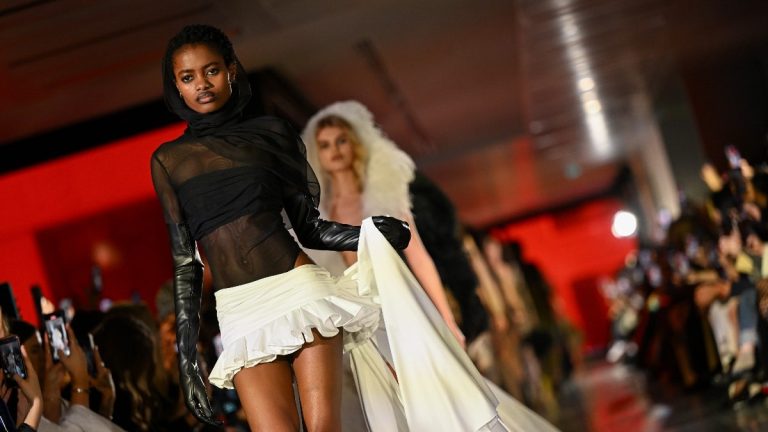“First and foremost, we are doing it for Ukrainian designers and the Ukrainian fashion industry,” says founder and CEO of Ukrainian Fashion Week Iryna Danylevska. “Journalists cover military events and tragedies that constantly take place in Ukraine. We wanted to speak in a different language and for the world to see us, hear us, and appreciate our resilience,” she says. “We expect Ukrainian Fashion Week will have a lot of attention from media and social media and it’s going to be a source of inspiration for the whole nation.”
Safety concerns
While the bulk of the fighting remains in Ukraine’s Eastern regions, there’s always the risk of air strikes in Kyiv, UFW organisers and designers acknowledge. The most recent air strike, on 8 July, struck a children’s hospital in the city. Forty-four people were killed, according to Reuters. (Russia denied carrying out the attack.)
The strike hit 500m away from Ukrainian brand Frolov’s production studio. “We felt the weight of the attack from our walls,” says founder Ivan Frolov. “The war is of course always a challenge, but as long as we’re doing this, I understand that there is nothing impossible for my team and for Ukrainians in general. And for us, this is the new normal, we have to continue.”
For safety during Ukrainian Fashion Week, there are bunkers on the main site, and at all external venues chosen by designers, there’s a bomb shelter “no more than 500m away”, Danylevska says. It’s a stirring reminder of the current reality in Kyiv. “We hope that all the brands on the schedule will not be interrupted by the air raid sirens and missile attacks and that they can introduce and present their collections,” Danylevska says.
There’s also practical challenges with the “new normal”. The vast majority of attendees will be from Ukraine, as the country remains on the red travel list or under travel warning for most major countries including the US, the UK and China. In the absence of international buyers, for the brands showing, UFW is about showing strength and boosting awareness of the Ukrainian fashion industry to the international press, while securing some orders from domestic buyers.
A lack of air connections to Ukraine makes deliveries costly and time consuming, while energy restrictions mean brands have to use generators to run their production studios. This is energy intensive and “super expensive, eating into profit margins”, Frolov says. That said, designers have found producing a show in Kyiv somewhat smoother because of the support and excitement of the local community and their familiarity with the city, compared with the cities they have shown in during the war.
Returning to the homeland
Frolov, a firm favourite of Sabrina Carpenter, hasn’t shown in Ukraine since 2020, when the pandemic broke out. Following the invasion, the brand decamped to London Fashion Week, where it has shown for the last three seasons. Frolov now has 17 stockists. But without the resources to move operations to another country, the designer and his teams remained in Ukraine, continuing to run their label from their studio in Kyiv. As the war wages on, far longer than he’d hoped, Frolov feels it’s time to return to showing in the capital, with a special performance show based on a Ukrainian fairytale Ivasyk-Telesyk. He has invited Ukraine’s artistic community, including film and theatre directors, artists and makeup artists, to celebrate the local arts industry.


